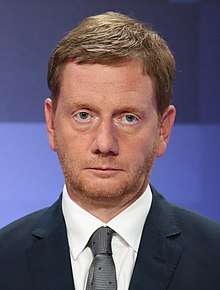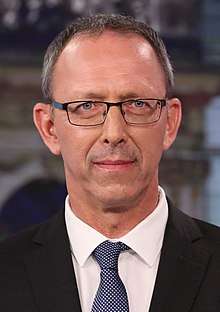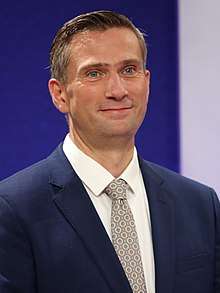2019 Saxony state election
The 2019 Saxony state election was held on 1 September 2019 to elect the members of the 7th Landtag of Saxony. The incumbent grand coalition of the Christian Democratic Union (CDU) and Social Democratic Party (SPD) led by Minister-President Michael Kretschmer was defeated, losing its majority.[1] The CDU subsequently formed a "Kenya coalition" with The Greens and the SPD, and Kretschmer was re-elected as Minister-President.[2]
| ||||||||||||||||||||||||||||||||||||||||||||||||||||||||||||||||||||
All 119 seats in the Landtag of Saxony 60 seats needed for a majority | ||||||||||||||||||||||||||||||||||||||||||||||||||||||||||||||||||||
|---|---|---|---|---|---|---|---|---|---|---|---|---|---|---|---|---|---|---|---|---|---|---|---|---|---|---|---|---|---|---|---|---|---|---|---|---|---|---|---|---|---|---|---|---|---|---|---|---|---|---|---|---|---|---|---|---|---|---|---|---|---|---|---|---|---|---|---|---|
| Turnout | 2,166,457 (66.5%) | |||||||||||||||||||||||||||||||||||||||||||||||||||||||||||||||||||
| ||||||||||||||||||||||||||||||||||||||||||||||||||||||||||||||||||||
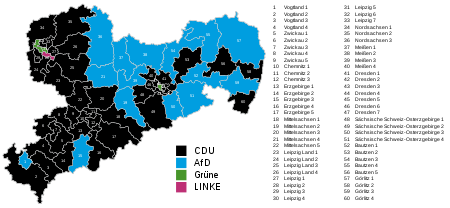 Results for the direct mandates. | ||||||||||||||||||||||||||||||||||||||||||||||||||||||||||||||||||||
| ||||||||||||||||||||||||||||||||||||||||||||||||||||||||||||||||||||
Background
In the 2014 state election, the CDU entered into coalition with the SPD. Since then, Saxony emerged as a stronghold of the Alternative for Germany (AfD), which achieved its best results in Saxony in national elections since. It won narrow pluralities in the state in both the 2017 federal election, winning 27.0%, and the 2019 European elections, winning 25.3%.[3]
In May 2019, the Saxon electoral commission ruled that two-thirds of AfD's candidate list was invalid due to the party's decision to split them across two lists.[4] However, in July, a court partially overturned this decision, ruling half of the party's list eligible.[5]
Parties
The table below lists parties represented in the 6th Landtag of Saxony.
| Name | Ideology | Leader(s) | 2014 result | |||
|---|---|---|---|---|---|---|
| Votes (%) | Seats | |||||
| CDU | Christian Democratic Union of Germany Christlich Demokratische Union Deutschlands |
Christian democracy | Michael Kretschmer | 39.4% | 59 / 126 | |
| Linke | The Left Die Linke |
Democratic socialism | Rico Gebhardt | 18.9% | 27 / 126 | |
| SPD | Social Democratic Party of Germany Sozialdemokratische Partei Deutschlands |
Social democracy | Martin Dulig | 12.4% | 18 / 126 | |
| AfD | Alternative for Germany Alternative für Deutschland |
National conservatism | Jörg Urban | 9.7% | 14 / 126 | |
| Grüne | Alliance 90/The Greens Bündnis 90/Die Grünen |
Green politics | Katja Meier Wolfram Günther |
5.7% | 8 / 126 | |
Opinion polling
Graphical summary
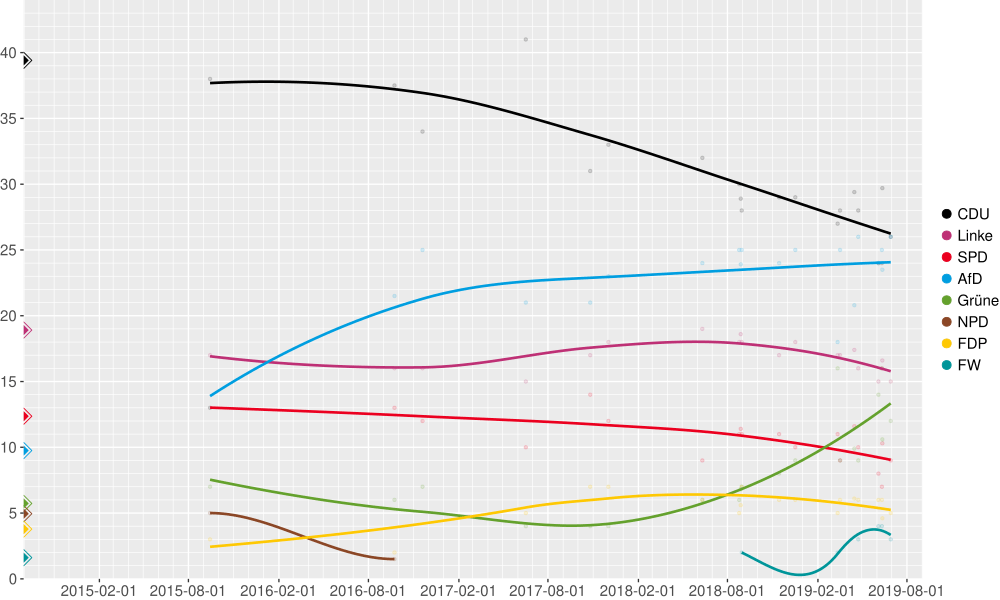
Party polling
| Polling firm | Fieldwork date | Sample size |
CDU | Linke | SPD | AfD | Grüne | NPD | FDP | Others | Lead |
|---|---|---|---|---|---|---|---|---|---|---|---|
| 2019 state election | 1 Sep 2019 | – | 32.1 | 10.4 | 7.7 | 27.5 | 8.6 | 0.6 | 4.5 | 8.6 | 4.6 |
| Forschungsgruppe Wahlen | 26–29 Aug 2019 | 1,657 | 32 | 14 | 8.5 | 24.5 | 11 | – | 5 | 5 | 7.5 |
| Civey | 4–28 Aug 2019 | 5,015 | 29.0 | 15.0 | 8.9 | 24.9 | 10.9 | – | 5.7 | 5.6 | 4.1 |
| INSA | 19–26 Aug 2019 | 1,018 | 29 | 15 | 8 | 25 | 11 | – | 5 | 7 | 4 |
| Forschungsgruppe Wahlen | 19–22 Aug 2019 | 1,068 | 31 | 14 | 9 | 25 | 10 | – | 5 | 6 | 6 |
| Infratest dimap | 19–21 Aug 2019 | 1,002 | 30 | 16 | 7 | 24 | 11 | – | 5 | 7 | 6 |
| Civey | 23 Jul–20 Aug 2019 | 5,016 | 28.0 | 15.0 | 8.5 | 25.2 | 11.4 | – | 5.5 | 6.4 | 2.8 |
| FB Czaplicki | 8–15 Aug 2019 | 700 | 28.0 | 16.0 | 8.0 | 26.0 | 13.0 | – | 5.0 | 4.0 | 2 |
| INSA | 22–31 Jul 2019 | 1,011 | 28 | 16 | 8 | 25 | 12 | – | 5 | 6 | 3 |
| Civey | 27 Jun–25 Jul 2019 | 5,019 | 27.1 | 15.0 | 8.7 | 25.4 | 10.8 | – | 5.6 | 7.4 | 1.7 |
| Infratest dimap | 24–29 Jun 2019 | 1,000 | 26 | 15 | 9 | 26 | 12 | – | 5 | 7 | Tie |
| Civey | 15 May–12 Jun 2019 | 5,001 | 29.7 | 16.6 | 10.3 | 23.5 | 10.6 | – | 4.6 | 4.7 | 6.2 |
| INSA | 4–11 Jun 2019 | 1,057 | 24 | 16 | 7 | 25 | 16 | – | 6 | 6 | 1 |
| FB Czaplicki | 29 May–4 Jun 2019 | 703 | 24 | 15 | 8 | 24 | 14 | – | 6 | 9 | Tie |
| 2019 European election | 26 May 2019 | – | 23.0 | 11.7 | 8.6 | 25.3 | 10.3 | 0.8 | 4.7 | 15.6 | 2.3 |
| INSA | 17–24 Apr 2019 | 1,000 | 28 | 16 | 10 | 26 | 9 | – | 6 | 5 | 2 |
| Civey | 19 Mar–16 Apr 2019 | 3,852 | 29.4 | 17.4 | 11.6 | 20.8 | 9.9 | – | 6.1 | 4.8 | 8.6 |
| INSA | 7–18 Mar 2019 | 1,028 | 28 | 17 | 9 | 25 | 9 | – | 6 | 6 | 3 |
| FB Czaplicki | 4–13 Mar 2019 | 703 | 27 | 17 | 11 | 18 | 16 | – | 5 | 6 | 9 |
| INSA | 10–17 Dec 2018 | 1,000 | 29 | 18 | 10 | 25 | 9 | – | 6 | 3 | 4 |
| IM Field | 2–14 Nov 2018 | 1,002 | 29 | 17 | 11 | 24 | 8 | – | 6 | 5 | 5 |
| INSA | 27–30 Aug 2018 | 1,040 | 28 | 18 | 11 | 25 | 7 | – | 7 | 4 | 3 |
| uniQma | 20–28 Aug 2018 | 703 | 28.9 | 18.6 | 11.4 | 23.9 | 6.8 | – | 5.6 | 4.5 | 5.0 |
| Infratest dimap | 20–25 Aug 2018 | 1,000 | 30 | 18 | 11 | 25 | 6 | – | 5 | 5 | 5 |
| INSA | 4–11 Jun 2018 | 1,009 | 32 | 19 | 9 | 24 | 6 | – | 6 | 4 | 8 |
| IM Field | 16 Nov–2 Dec 2017 | 1,000 | 33 | 18 | 12 | 23 | 4 | – | 7 | 3 | 10 |
| IM Field | 23–26 Oct 2017 | 1,005 | 31 | 17 | 14 | 21 | 4 | – | 7 | 5 | 10 |
| 2017 federal election | 24 Sep 2017 | – | 26.9 | 16.1 | 10.5 | 27.0 | 4.6 | 1.1 | 8.2 | 5.6 | 0.2 |
| Infratest dimap | 12–17 Jun 2017 | 1,000 | 41 | 15 | 10 | 21 | 4 | – | 5 | 4 | 20 |
| Infratest dimap | 15–19 Nov 2016 | 1,002 | 34 | 16 | 12 | 25 | 7 | – | – | 6 | 9 |
| INSA | 19–23 Sep 2016 | 1,003 | 37.5 | 16 | 13 | 21.5 | 6 | 1.5 | 2 | 2.5 | 16 |
| Infratest dimap | 9–14 Sep 2015 | 1,001 | 38 | 17 | 13 | 13 | 7 | 5 | 3 | 4 | 21 |
| 2014 state election | 31 Aug 2014 | – | 39.4 | 18.9 | 12.4 | 9.7 | 5.7 | 4.9 | 3.8 | 5.1 | 20.5 |
Election result
Summary of the 1 September 2019 election results[6] for the Landtag of Saxony
 | ||||||||
| Party | Ideology | Votes | Votes % (change) | Seats (change) | Seats % | |||
|---|---|---|---|---|---|---|---|---|
| Christian Democratic Union (CDU) | Christian democracy | 695,560 | 32.1% | −7.3pp | 45 | −14 | 37.8% | |
| Alternative for Germany (AfD) | German nationalism | 595,671 | 27.5% | +17.7pp | 38 | +24 | 31.9% | |
| The Left (Die Linke) | Democratic socialism | 224,354 | 10.4% | −8.5pp | 14 | −13 | 11.8% | |
| Alliance '90/The Greens (Grünen) | Green politics | 187,015 | 8.6% | +2.9pp | 12 | +4 | 10.1% | |
| Social Democratic Party (SPD) | Social democracy | 167,289 | 7.7% | −4.6pp | 10 | −8 | 8.4% | |
| Free Democratic Party (FDP) | Liberalism | 97,438 | 4.5% | +0.7pp | 0 | ±0 | 0% | |
| Free Voters | Direct democracy | 72,897 | 3.4% | +1.8pp | 0 | ±0 | 0% | |
| Others | 126,233 | 5.8% | −2.7pp | 0 | ±0 | 0% | ||
| Total | 2,166,457 | 100.0% | 119 | −7 | 100.0% | |||
| Blank and invalid votes | 22,029 | 1.02 | ||||||
| Registered voters / turnout | 3,288,643 | 66.5 | ||||||
AfD received its highest share of the vote in any state or federal election, while the CDU and The Left both fell to record lows in Saxony. Under normal circumstances AfD should have received 39 seats in the Landtag; however, due to positions 31–61 being ruled invalid and removed from AfD's party list, they had no candidates to fill the final seat. Thus, it remains vacant and there are only 119 seats in the Landtag, one fewer than the standard minimum size.
Government formation
Incumbent Minister-President Michael Kretschmer was considered likely to retain his job, as his party remains the largest in the Landtag. Kretschmer ruled out working with AfD or leading a minority government during the campaign. As the CDU also rejects working with The Left, this leaves a so-called "Kenya coalition" as the only viable option: a coalition of the CDU, Greens, and SPD. Such a coalition has governed Saxony-Anhalt since the 2016 state election.[7] Kretschmer and Green leaders Meier and Günther publicly supported exploratory discussions in the week following the election, and the Greens scheduled a party vote on opening negotiations for 12 October.[8]
On 20 December, the coalition between the CDU, Greens, and SPD was approved by the Landtag and sworn into government, with Kretschmer remaining as Minister-President.[2]
References
- "Umfrage-Beben in Sachsen: AfD auf Augenhöhe mit der CDU". merkur.de (in German). 2019-04-27. Retrieved 2019-05-05.
- "Sachsens Kenia-Regierung ist besiegelt". MDR.de. 20 December 2019.
- https://www.dw.com/en/eu-election-afd-surge-in-eastern-germany-sets-up-clash-of-cultures/a-48909859
- https://www.politico.eu/article/afd-in-regional-election-administrative-oversight/
- https://www.politico.eu/article/german-court-partially-overturns-restrictions-on-far-right-afd-election-list/
- Anzlinger, Jana (2 September 2019). "Landtagswahl: Diese Koalitionen sind möglich". Süddeutsche Zeitung (in German).
- "CDU-Landeschef in Sachsen: Kretschmer für Kenia-Koalition". ZDF (in German).
